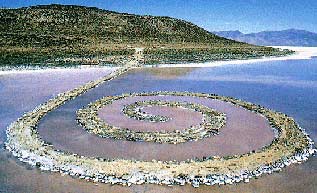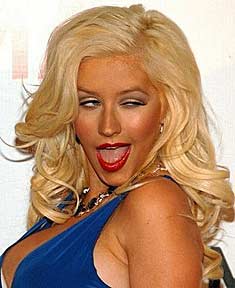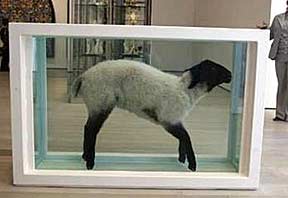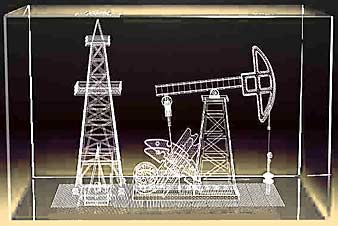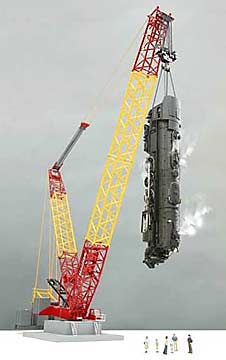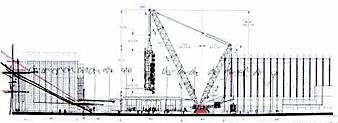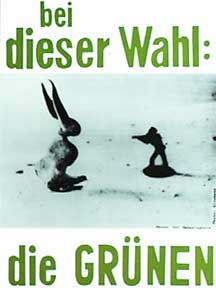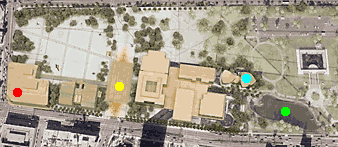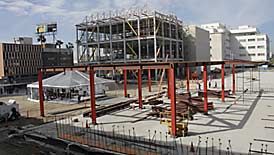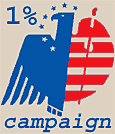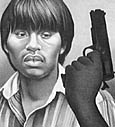I’m not sure just when the Los Angeles County Museum of Art acquired the services of the high-powered public relations firm of Hill and Knowlton, Inc. (H&K), but I first noticed the PR firm’s name included as a media contact on an official LACMA press release dated Feb. 3, 2006. The announcement was for the appointment of Michael Govan as the museum’s new Director and Chief Executive Officer (see the
.pdf file.) When LACMA made known on March 6, 2007, that oil giant BP had given $25 million to the museum - LACMA’s official press release again included H&K as a media contact (
.pdf file.)
I have absolutely no objections to LACMA using a PR firm to effectively promote itself, nor would I criticize an individual for doing the same - but Hill and Knowlton, Inc. has a long and controversial roster of clients that I think readers of my web log should be aware of. A leading public relations corporation, H&K has 71 offices in 40 countries, with specialists in "crisis & issues management" as well as the oil and petrochemical industry. After reading some of the following, you may wonder what on earth has been going on behind closed doors at LACMA’s board of directors meetings.
Hill and Knowlton, Inc. became infamous over its dealings with the tobacco industry in the 1950s. In 2004 the U.S. Department of Justice finally sued the tobacco industry for $280 billion in damages, arguing that in 1953, the five major cigarette manufacturers met with "public relations firm Hill & Knowlton and agreed to jointly conduct a long term public relations campaign to counter the growing evidence linking smoking as a cause of serious diseases." In August of 2006, a U.S. District Judge ruled that the tobacco companies had violated civil racketeering laws by conspiring for decades to deceive the public about the dangers of smoking - however, the judge did not order the monetary penalty proposed by the government (the case is currently being appealed.)
Lord of the lies; how Hill and Knowlton's Robert Gray pulls Washington's strings, written by Susan B. Trento and published by the Washington Monthly in Sept, 1992, detailed much of the PR firm’s skullduggery under the chairmanship of Gray. Trento wrote that for 30 years, Hill and Knowlton, "set a standard - not a particularly high one for what Washington lobbying can get away with (….) Whether the client was Haiti’s 'Baby Doc' Duvalier or the Church of Scientology, the only criterion was that the client paid - and paid well." Sheila Tate, a former H&K employee and later Nancy Reagan’s press secretary, described the PR firm as a "company without a moral rudder" for its controversial client list.
The Center for Public Integrity published a 1992 report titled, The Torturers’ Lobby, describing the use of PR firms by repressive regimes (view in .pdf or html.) Hill and Knowlton, Inc. topped the list of earnings, making $14 million in one year by representing governments that abuse human rights like China, Indonesia, Egypt, Peru, and Turkey. Human Rights groups have long condemned Turkey for abusing its citizens of Kurdish origin, but the center’s report stated that H&K earned $1.2 million from Turkey between 1991-1992. H&K even took the Chinese government as a client soon after its massacre of dissidents at Tiananmen Square in 1989 (source: Human Rights in China website - .pdf.) In May of 2005, Agence France-Presse reported that H&K signed a $600,000 contract with the government of Uganda, to "improve Uganda’s stained reputation as a human rights abuser and democracy laggard."
In December of 1984, a Union Carbide pesticide plant in Bhopal, India, leaked 40 tons of lethal gas over the city, in what was to become the world’s worst industrial disaster. Some 8,000 people died in the first few days, and approximately 20,000 are believed to have perished in the aftermath. Today over 120,000 people in Bhopal continue to suffer health problems as a result of the disaster - blindness, cancer, serious birth-defects, and other ailments. A proper clean up of the plant and its environs has never taken place, and in Nov., 2004, the BBC reported that thousands of tons of toxic chemicals are still loose on the ground or held in open containers. Hill & Knowlton, Inc. handled Union Carbide’s PR troubles during the disaster, and H&K’s Executive Vice President, Richard C. Hyde, lead the "crisis management" team that assisted Union Carbide.
Hill & Knowlton, Inc. is currently the public relations firm for the Nuclear Energy Institute (NEI), the organization that represents the nuclear power industry. In a February 6th, 2006, Wall Street Journal article titled, Nuclear Industry Plans Ad Push For New Plants (Sub req'd), the paper reported that the "nation’s nuclear-power industry is set to roll out a multiyear advertising campaign to build public support for a generation of new plants" - and the ad campaign which promotes a "nuclear renaissance" is run by H&K. In a June 2006 editorial, the Columbia Journalism Review reported that the PR firm helped the NEI form the so-called "Clean and Safe Energy Coalition," a front group that would sing the praises of nuclear energy for the corporate media. The Review wrote, "We just find it maddening that Hill & Knowlton, which has an $8 million account with the nuclear industry, should have such an easy time working the press." That multi-million dollar contract stipulates "pre-empting and offsetting criticism from opponents."
While we’re on the subject - when the Three-Mile Island nuclear plant in Harrisburg, Pennsylvania, had a partial core meltdown on March 28th, 1979, it was Hill & Knowlton, Inc. executive, Robert Dilenschneider, who was brought in to handle PR for the plant’s operators, Metropolitan Edison.
Hill & Knowlton, Inc. is probably most notorious for its work with the government of Kuwait in organizing and running the propaganda campaign aimed at getting the U.S. public to support military action against Iraq. On August 2nd, 1990, Saddam Hussein began Iraq’s invasion and 7 month-long occupation of neighboring Kuwait. Within a few days the Iraqis had completely overrun the Kuwaiti Armed Forces, and with more than 100,000 Iraqi soldiers and 700 tanks on Kuwait’s territory, the Kuwaiti Royal Family escaped to next door Saudi Arabia.
From exile the Kuwaiti government would employ as many as 20 PR firms in its campaign to mobilize U.S. public opinion (source: O'Dwyer's PR Services Report, Vol. 5, No. 1, Jan. 1991 - "H&K leads PR charge in behalf of Kuwaiti cause.") But the Kuwaitis would ultimately pay $10.8 million to H&K for a massive media blitz. On October 10, 1990, H&K orchestrated the appearance of a 15-year-old Kuwaiti girl, identified only as Nayirah, before the Congressional Human Rights Caucus in Washington. The youngster wept as she told of her harrowing experience in occupied Kuwait City. "I volunteered at the al-Addan hospital. While I was there I saw the Iraqi soldiers come into the hospital with guns and go into the room where babies were in incubators. They took the babies out of the incubators, took the incubators, and left the babies on the cold floor to die."
After Nayirah’s emotional testimony, President George H.W. Bush quoted her many times in addresses to the American people. For instance, at a Nov. 1st., 1990 Republican rally in Massachusetts, he said of the Iraqi invaders, "They have committed outrageous acts of barbarism. In one hospital, they pulled 22 premature babies from their incubators, sent the machines back to Baghdad, and all those little ones died." At an Oct. 16th, 1990, fundraiser in Des Moines, Iowa, he said of the Iraqi occupiers, "I don't mean to be overly shocking here - but let me just mention some reports, firsthand reports. At a hospital, Iraqi soldiers unplugged the oxygen to incubators supporting 22 premature babies. They all died. And then they shot the hospital employees." A number of Senators also used Nayirah’s testimony in the same way, and the shocking story was repeated innumerable times in radio, television, and newspaper reports.
After the war, investigations found absolutely no evidence to support the incubator claims. As it turned out, Nayirah was a member of the Kuwaiti royal family, and her father was Kuwait’s Ambassador to the U.S., Saud Nasir Al-Sabah. The youngster never worked at the al-Addan hospital and under no circumstances had been witness to the butchery she recounted. Nayirah’s story was completely fabricated, and H&K’s vice-president Lauri Fitz-Pegado had coached the teenager in false testimony.
The record of Hill and Knowlton, Inc. as a dodgy and immoral PR firm is extensive, and itemizing their misconduct and crimes is beyond the scope of this web log. The facts I’ve researched and presented here are public knowledge - one can only imagine the skeletons in the closet. If you take the time to conduct your own research, you’ll find information on many other controversies surrounding H&K. In 1983 it managed PR for the building materials manufacturers, U.S. Gypsum, aimed at downplaying the connection between asbestos and health problems. The firm took an estimated $5 million from the National Conference of Catholic Bishops in 1990 to wage an anti-abortion PR campaign. In 2004 H&K began working with Wal-Mart in order to rehabilitate the image of the Union busting retail company. The larger question is, why did LACMA take into service a high-powered corporate PR firm so tainted with unseemliness?
Conceivably the Los Angeles County Museum of Art, in employing Hill and Knowlton, Inc. merely wanted to increase its profile with the general public. Or perhaps, realizing that their relationship with a major oil company would be seen as a liability, the vaunted arts institution decided to implement damage control - my suspicions point to the latter. What LACMA might be paying H&K for its services is not public knowledge, but the PR firm does not come cheap. Likewise, while it’s not known exactly what H&K is doing for LACMA, insiders in the lobbying and public relations industry have a saying, "the best PR is invisible."
So the next time you’re exposed to a radio spot, television news segment, magazine article, or glowing press review extolling LACMA and its big oil benefactor, you might be consuming propaganda from hired guns Hill and Knowlton, Inc. When you read that Michael Govan, the director and CEO of LACMA, praised oil giant BP for "their commitment to sustainable energy," you may have the feeling he was coached by the PR firm - and you just might be right.
Labels: Artists and the Iraq war, BP Grand Entrance, LACMA, Michael Govan
